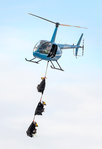Clear, 30° F
After landowners near Bighorn Canyon National Recreation Area sounded the alarm of a die-off of bighorn sheep, Wyoming Game and Fish officials rushing to the scene found more than three dozen of the …
This item is available in full to subscribers.
The Powell Tribune has expanded its online content. To continue reading, you will need to either log in to your subscriber account, or purchase a subscription.
If you are a current print subscriber, you can set up a free web account by clicking here.
If you already have a web account, but need to reset it, you can do so by clicking here.
If you would like to purchase a subscription click here.
Please log in to continue |
|




After landowners near Bighorn Canyon National Recreation Area sounded the alarm of a die-off of bighorn sheep, Wyoming Game and Fish officials rushing to the scene found more than three dozen of the iconic species dead and dying in the state’s prized Devil Canyon herd.
Wildlife biologists immediately collected biological samples, including nasal and tonsil swabs and tissue, from carcasses at the site. They then sent the samples to Laramie for analysis by the department’s Wildlife Health Laboratory. They discovered the cause of death is a pathogenic strain of the bacteria Mannheimia haemolytica, known to cause lethal pneumonia in sheep.
The majority of deaths occurred in ewes and lambs, with only a few young rams — 1- to 2-year-olds — still with the group succumbing. Adult rams live more solitary lives most of the year, but the rut will be starting soon, bringing them into contact with larger groups and concerning wildlife managers.
The Devil Canyon herd has traditionally been one of the healthiest, most disease-resistant herds in the state. It is often selected for translocations when other Wyoming herds are in need of being supplemented, said Corey Class, Cody Region wildlife management coordinator.
“For the most part it’s a relatively clean herd,” he said.
The herd hasn’t had many cases of ovipneumoniae in the past, a disease that has plagued the species in other locations in the Rocky Mountain range. Class said the hope is Mannheimia haemolytica bacteria doesn’t live as long and will pass before rams come down to join the groups.
“We’re hoping this disease is very different than your standard pneumonia issues that we’ve had with other sheep herds,” he said. “We’ve lost a lot of sheep. But in the long run, we might come out of this OK. But I don’t have a crystal ball.”
The source of the infection is unknown, the department said in a Monday press release.
Wildlife Health Laboratory supervisor Hank Edwards said he hopes the outbreak can be contained.
“Our limited experience with this pathogen gives us some hope the outbreak will run its course quickly, with minimal mortalities,” he said.
The 37 that have died so far is more than 10% of the herd, which was estimated to be trending at about 300 individuals prior to the outbreak.
“It was one of the worst things I’ve seen in my career to see 37 dead bighorn sheep. It was a bad day, but I’m hoping there’s a silver lining,” Class said.
Game and Fish is actively monitoring the population and any further or potential spread of pneumonia. Biologists are counting on GPS transmitters to alert them to future deaths.
Currently, 24 bighorn sheep in this herd are fitted with GPS tracking collars to monitor distribution, habitat use, seasonal movement, annual recruitment and survival rates.
“The collars will now help us monitor bighorn sheep populations from a disease perspective and document additional mortalities,” Class said.
When a collared sheep dies, officials are immediately alerted by text and emails sent by the transmitter.
Class said cooperation from landowners is essential to managing the herd.
“We have been working closely with a local landowner who has been key to managing and monitoring this disease outbreak,” Class said. “We greatly appreciate their assistance and cooperation.”
All bighorn sheep carcasses were disposed of to decrease spread of the disease. The herd isn’t in contact with other herds in the area and it is hoped this will be an isolated case in the species’ prime habitat. The department had a similar outbreak near Laramie Peak, southwest of Douglas.
“It seems like the Laramie Peak herd appears to be doing better now,” Class said. “Our hope is that this disease kind of burns itself out because it moves so fast.”
Game and Fish is requesting anyone seeing dead or dying bighorn sheep in the area call Cody Region offices at 307-527-7125.